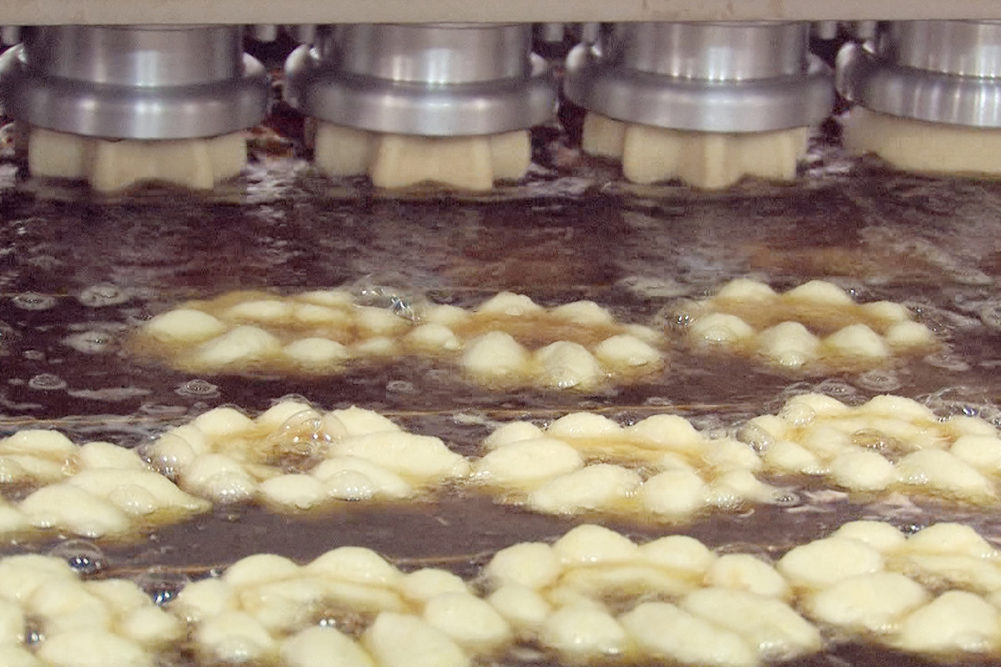When introducing new donut shapes or sizes, fryer flexibility shouldn't be overlooked.
“Our equipment’s standard features have inherent flexibility to produce seasonal products, so we don’t need to supply different fryers, nor do our fryers require modifications for items like seasonal products,” said Rich Rinier, Eastern regional sales manager, processing systems division, Heat and Control.
It’s important to remember the specific differences between different shapes the line will produce. For instance, if the size or weight of the shaped donuts are relatively similar, it’s probably not going to impact the frying parameters. But some products like berliners have a denser dough with a relatively longer fry time or require several turns in the fryer.
“If it’s a cake donut, will a new variety have an ‘upside’ and a ‘downside’?” asked Mike Baxter, product information and marketing coordinator, Belshaw Adamatic Bakery Group. “If so, it might need to be turned twice, and it may require two turners in the fryer instead of just one.”
And mini donut holes — for yeast-raised or cake — need specific frying considerations, too.
“Our submerger for donut holes takes just seconds to lower into place, and our quick-change turner system allows an extra turner to be lowered in less than a minute,” he added.
If a baker is adding a new variety into the current lineup, time and space must be on the radar.
“If they are adding shapes and sizes to the existing fryers, they need to be certain the spacing of the flights and the flip mechanism are adequate to handle the full range,” said Doug Kozenski, processing industry manager, Heat and Control. “For yeast donuts, they must be certain the timing between the proofer and fryer can accommodate the range of products they plan to run as well.”
Heat and Control also offers its Overhead Weir System that cascades hot oil over donut holes.
“This system gently spins/rotates round products for improved quality by eliminating belt marks,” Mr. Rinier said.
[Related reading: How donut makers can go beyond the ring]
David Moline, vice president, sales and marketing, agreed that size is an important factor.
“When you’re considering a variety of shapes, the first thing to consider is the size,” he said. “When we design the donut fryer, it has to accommodate the largest shape, so you’ve got to know what that will be on the front side. When you have a continuous line, the ratio of fry time to proof time is fixed, so you have to make sure you’re operating within a proper window.”
Shape becomes a factor in the fryer when it impacts the oil’s ability to penetrate the core of the product.
“The further the oil is from the product’s core the longer the frying time will be,” said Ken Weekes, international sales manager, WP Bakery Systems.
“Viscosity will affect the final shape, relative complexity of the shape. The more intricate, the stiffer the dough will have to be.”
He advised bakers to avoid creating donut shapes with extreme intricacies as it affects not only the frying time but also proofing parameters.
“If the shape has more mass/dough than the ring, then you will need different proofing time and temperature and sufficient space for the product,” Mr. Weekes added. “Adjusting the proofing time and temperature are standard adjustments in our system. But the product size must be discussed before the line is manufactured.”
Moline manufactures complete systems, so Mr. Moline also emphasized the importance of planning upfront.
“We can make a wide variety of shapes, but planning for them on the front end allows us to tailor the equipment properly,” he said. “Fryers can be equipped with or without submergers, and we need to make sure our proofers have the proper zone control. We always have dual-zone proofers with two climate zones. We also have different methods of loading our proofers automatically, and that’s often dictated by product size and shape.”
This article is an excerpt from the June 2020 issue of Baking & Snack. To read the entire feature on donut tech, click here.





